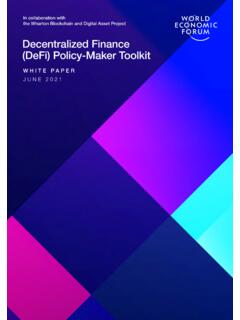Transcription of DeFi Beyond the Hype - Wharton Initiative on Financial ...
1 The Wharton School The University of pennsylvania DeFi Beyond the hype | 1 Introduction Decentralized Finance (DeFi) is a developing area at the intersection of blockchain, digital assets, and Financial services. DeFi protocols seek to disintermediate finance through both familiar and new service arrangements. The market experienced explosive growth beginning in 2020. According to tracking service DeFi Pulse, the value of digital assets1 locked into DeFi services grew from less than $1 billion in 2019 to over $15 billion at the end of 2020, and over $80 billion in May Yet DeFi is still early in its maturation.
2 The goal of this report is to demystify DeFi. It describes the basic attributes of DeFi services, the structure of the DeFi ecosystem, and emerging developments. A forthcoming Decentralized Finance Policy-Maker Toolkit will offer guidance on risks and policy approaches for governments navigating this new space. DeFi is a general term covering a variety of activities and business relationships. We identify six major DeFi service categories stablecoins, exchanges, credit, derivatives, insurance, and asset management as well as auxiliary services such as wallets and oracles.
3 While traditional finance relies on intermediaries to manage and process Financial services, DeFi operates in a decentralized environment public, permissionless blockchains. Services are generally encoded in open-source software protocols and smart contracts. Like blockchain technology more generally, DeFi has an enthusiastic base of evangelists, who promote its potential for efficiency, transparency, innovation, and Financial inclusion. It also has its critics, risks, and unknowns. There have already been significant examples of fraud, attacks, governance controversies, and other failures in the DeFi world.
4 At this early stage, it is essential for industry and governments alike to develop a well-informed and nuanced understanding of the opportunities, risks, and challenges. DeFi Beyond the hype The Emerging World of Decentralized Finance Produced by the Wharton Blockchain and Digital Asset Project, in collaboration with the World Economic Forum May 2021 The Blockchain and Digital Asset Project is a program of the Wharton Initiative on Financial Policy and Regulation. It is led by Professor Kevin Werbach. Drawing on the expertise of the Wharton School and a global network of contributors, the project studies the business and regulatory implications of distributed ledger technology.
5 For further information, please contact The Wharton School The University of pennsylvania DeFi Beyond the hype | 2 What is DeFi? THE FUNDAMENTALS DeFi is a general term for decentralized applications (Dapps) providing Financial services on a blockchain settlement layer, including payments, lending, trading, investments, insurance, and asset management. DeFi services typically operate without centralized intermediaries or institutions, and use open protocols that allow services to be programmatically combined in flexible ways.
6 Historically, intermediaries have played essential roles within Financial markets, serving as agents and brokers of trust, liquidity, settlement, and security. The range and value of intermediaries has grown over time to meet the needs of an increasingly complex Financial system. Since the 2008 Global Financial Crisis, there has been increased attention on inefficiencies, structural inequalities, and hidden risks of the intermediated Financial More recently, controversies such as the GameStop short squeeze, in which retail investors were blocked from trading during a period of volatility, cast a spotlight on other shortcomings of legacy Financial infrastructure.
7 Slow settlement cycles, inefficient price discovery, liquidity challenges, and the lack of assurance around underlying DeFi aims to address some of these challenges though many still apply to the DeFi ecosystem in its current state. DeFi leverages blockchain technology to facilitate alternatives to traditional service providers and market structures. It offers the potential for innovation and creation of new services for improving efficiency of Financial markets building upon work being done in Financial technology (fintech) and blockchain technology more broadly.
8 Whether it achieves this promise remains to be seen. DeFi Building Blocks DeFi takes advantage of various technologies developed in the blockchain sphere. All have applications outside of DeFi, but play essential roles within the DeFi ecosystem. Blockchains: Distributed ledgers serving as the settlement layer for transactions. Currently, most DeFi services operate on the Ethereum network, due to its capabilities and developer DeFi activity is growing on and across other blockchains as well. Digital Assets: Tokens representing value that can be traded or transferred within a blockchain network.
9 Bitcoin and other cryptocurrencies were the first blockchain-based digital assets. Others have a range of intended functions Beyond payments. Wallets: Software interfaces for users to manage assets stored on a blockchain. With a non-custodial wallet, the user has exclusive control of funds through their private keys. With custodial wallets, private keys are managed by a service provider. The Wharton School The University of pennsylvania DeFi Beyond the hype | 3 Smart Contracts: Blockchain-based software code that carries out, controls, and documents relevant events and actions according to predefined terms and rules.
10 Decentralized Applications (Dapps): Software applications built out of smart contracts, often integrated with user-facing interfaces using traditional web technology. Governance Systems: Software-based mechanisms that manage changes to smart contracts or other blockchain protocols, often based on tokens that allocate voting rights to stakeholders. Decentralized Autonomous Organizations (DAOs): Entities whose rules are defined and enforced in the form of smart contracts. Stablecoins: Digital assets whose values are pegged to a fiat currency, a basket of fiat currencies or other stable-value assets.
